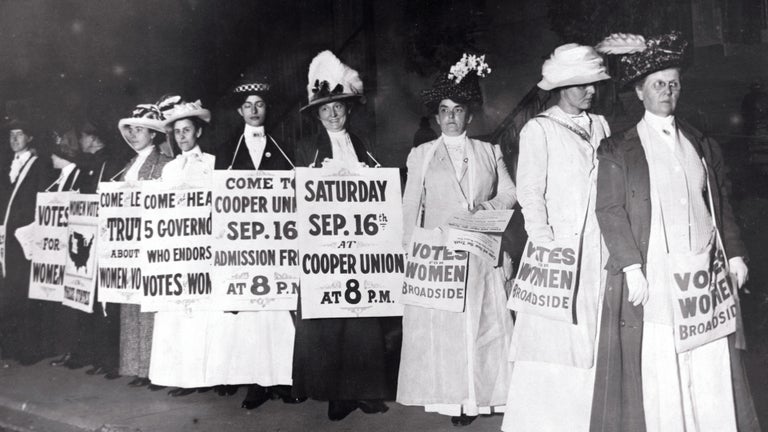The fight for women’s suffrage has been a long and arduous journey that has played a crucial role in shaping the political landscape of many countries. From the late 19th century to the present day, women have been advocating for their right to vote, paving the way for greater gender equality in the political sphere. The political history of the women’s suffrage movement is a tale of resilience, determination, and unwavering commitment to achieving a fundamental human right.

Credit: journals.sagepub.com
The Origins of the Women’s Suffrage Movement
At the heart of the women’s suffrage movement is the demand for equality and representation in the political system. The movement traces its origins back to the 19th century, where women began to question their role in society and sought to challenge the prevailing norms that denied them a voice in decision-making processes. The Seneca Falls Convention in 1848, organized by prominent suffragists including Elizabeth Cady Stanton and Lucretia Mott, marked the beginning of a sustained effort towards achieving voting rights for women in the United States.
Key Milestones In The Women’s Suffrage Movement
As the movement gained momentum, women from various countries embarked on a relentless campaign to secure the right to vote. In the United Kingdom, the Suffragette movement, led by Emmeline Pankhurst and her daughters, notably advocated for women’s suffrage through militant and non-violent tactics. Their resilience and strategic activism brought significant attention to the cause, leading to the eventual passage of the Representation of the People Act in 1918, granting voting rights to certain categories of women in the UK.
In the United States, the ratification of the 19th Amendment to the Constitution in 1920 was a watershed moment in the women’s suffrage movement. This historic achievement came after decades of tireless campaigning, grassroots organizing, and relentless advocacy by suffragists such as Susan B. Anthony, Alice Paul, and Sojourner Truth. The amendment prohibited the denial of voting rights based on gender, marking a pivotal victory for gender equality in the realm of politics.
Global Impact and Legacy
The impact of the women’s suffrage movement reverberated across the globe, inspiring women in other countries to mobilize and demand their right to participate in the democratic process. Over the years, numerous nations have made significant strides in granting women the right to vote and stand for public office, recognizing the invaluable contributions and perspectives that women bring to governance and policymaking.
Challenges And Ongoing Advocacy
Despite the monumental achievements of the women’s suffrage movement, the journey towards gender parity in political representation is far from over. Women continue to face barriers and systemic challenges in accessing political leadership roles, and the fight for inclusive and equitable political participation remains an ongoing endeavor. Advocacy groups and organizations continue to push for legislative reforms and societal shifts that will create a more inclusive and diverse political landscape.

Credit: www.licensestorehouse.com
Frequently Asked Questions On Unveiling The Empowering Political History Of The Women’s Suffrage Movement
What Were The Main Goals Of The Women’s Suffrage Movement?
The main goals of the Women’s Suffrage Movement were to secure voting rights for women and achieve gender equality in society.
How Did The Women’s Suffrage Movement Start?
The Women’s Suffrage Movement started with the Seneca Falls Convention in 1848, where women gathered to discuss their rights and forge a path towards suffrage.
Who Were The Key Figures In The Women’s Suffrage Movement?
Key figures in the Women’s Suffrage Movement included Susan B. Anthony, Elizabeth Cady Stanton, and Alice Paul, who advocated tirelessly for women’s right to vote.
What Were The Major Obstacles Faced By The Women’s Suffrage Movement?
The Women’s Suffrage Movement faced major obstacles such as opposition from men and conservative groups, societal prejudices, and legal barriers that hindered progress.
Conclusion
The political history of the women’s suffrage movement stands as a testament to the power of collective action, resilience, and unwavering commitment to justice and equality. From the pioneering efforts of early suffragists to the ongoing advocacy for greater representation in political leadership, the women’s suffrage movement holds a significant place in the annals of political history, serving as a reminder of the progress made and the work that still lies ahead in creating a truly inclusive and representative democracy.
Guest Author Sakhawat-Shuvo wrote and edited this Article based on his best knowledge and understanding. These opinions and remarks are not endorsed or guaranteed by epichistoria.com or EpicHistoria. The Epic Historia does not guarantee this article’s content. Readers should verify and use their judgment before trusting the content. Also, the Images used in this Article are the copyright of their Respective Owners. Please use our Comment Box or Contact Us form to report this content. This information is not accountable for losses, injuries, or damages.

